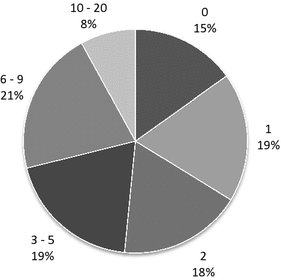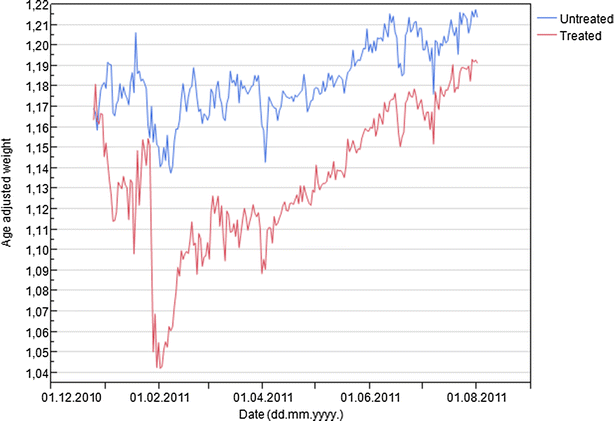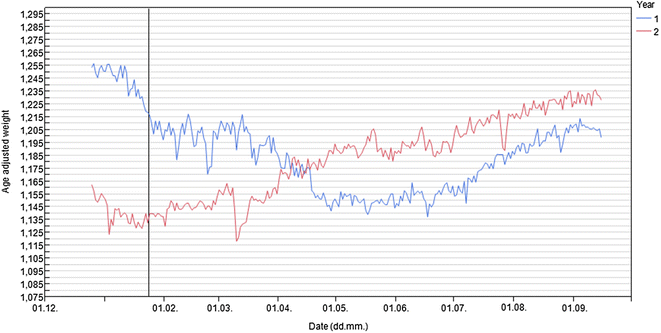Bovine respiratory syncytial virus outbreak reduced bulls' weight gain and feed conversion for eight months in a Norwegian beef herd
- PMID: 26810215
- PMCID: PMC4727385
- DOI: 10.1186/s13028-016-0190-y
Bovine respiratory syncytial virus outbreak reduced bulls' weight gain and feed conversion for eight months in a Norwegian beef herd
Abstract
Background: Cost-benefit evaluation of measures against respiratory disease in cattle requires accounting with the associated production losses. Investigations of naturally occurring respiratory infections in a herd setting are an opportunity for accurate estimates of the consequences. This article presents estimates based on individual monitoring of weight and concentrate intake of several hundred bulls previous to, during and after a respiratory infection outbreak with bovine respiratory syncytial virus (BRSV) as the main pathogen. The aim of the study was to analyse the association between exposure to BRSV, weight gain and feed conversion rate, quantify any change in these parameters, and estimate the duration of the change in production.
Results: A comparison of growth curves for the bulls that were present during the outbreak revealed that bulls with severe clinical signs had a clear and consistent trend of poorer growth rate than those with milder or no signs. The weight/age-ratio was 0.04-0.10 lower in the severely affected bulls, and evident throughout the study period of 8 months. A comparison of growth rates between apparently healthy bulls being present during the outbreak and a comparable group of bulls exactly 1 year later (n = 377) showed a reduced growth rate of 111 g/day in the first group. The difference amounted to 23 extra days needed to reach the reference weight. Feed conversion was also reduced by 79 g weight gain/kilogram concentrate consumed in the outbreak year.
Conclusion: This study indicates significant negative effects on performance of animals that develop severe clinical signs in the acute stage, and that the growth and production is negatively affected many months after apparent recovery. In addition, the performance of apparently healthy animals that are exposed during an outbreak are severely negatively affected. The duration of this decrease in production in animals after recovery, or animals that have not shown disease at all, has not previously been documented. These losses will easily be underestimated, but contribute significantly to the costs for the producer. The findings emphasize the importance of BRSV infection for profitability and animal welfare in cattle husbandry. The study also illustrates that utilising intra-herd comparison of health and production parameters is a productive approach to estimate consequences of an outbreak.
Figures




Similar articles
-
Risk factors for epidemic respiratory disease in Norwegian cattle herds.Prev Vet Med. 2000 Mar 29;44(1-2):87-96. doi: 10.1016/s0167-5877(99)00113-0. Prev Vet Med. 2000. PMID: 10727746
-
Highly pathogenic Bovine Respiratory Syncytial virus variant in a dairy herd in Italy.Vet Med Sci. 2020 Nov;6(4):740-745. doi: 10.1002/vms3.312. Epub 2020 Jun 28. Vet Med Sci. 2020. PMID: 32594662 Free PMC article.
-
The effect of an outbreak of respiratory disease on herd-level milk production of Norwegian dairy farms.Prev Vet Med. 2001 Oct 11;51(3-4):259-68. doi: 10.1016/s0167-5877(01)00223-9. Prev Vet Med. 2001. PMID: 11535284
-
Respiratory syncytial virus infection in cattle.Vet Pathol. 2014 Mar;51(2):427-36. doi: 10.1177/0300985813501341. Epub 2013 Sep 5. Vet Pathol. 2014. PMID: 24009269 Review.
-
Bovine respiratory syncytial virus infection: immunopathogenic mechanisms.Anim Health Res Rev. 2007 Dec;8(2):207-13. doi: 10.1017/S1466252307001405. Anim Health Res Rev. 2007. PMID: 18218161 Review.
Cited by
-
Molecular characterization of G and F protein genes of bovine respiratory syncytial virus detected from dead calves caused by severe respiratory syndrome: emergence of novel mutations and their importance.Virusdisease. 2023 Dec;34(4):539-549. doi: 10.1007/s13337-023-00846-7. Epub 2023 Nov 7. Virusdisease. 2023. PMID: 38046057 Free PMC article.
-
Bovine respiratory syncytial virus in experimentally exposed and rechallenged calves; viral shedding related to clinical signs and the potential for transmission.BMC Vet Res. 2019 May 20;15(1):156. doi: 10.1186/s12917-019-1911-z. BMC Vet Res. 2019. PMID: 31109324 Free PMC article.
-
Associations between Bovine Coronavirus and Bovine Respiratory Syncytial Virus Infections and Productivity, Health Status and Occurrence of Antimicrobial Resistance in Swedish Dairy Herds.Antibiotics (Basel). 2021 May 27;10(6):641. doi: 10.3390/antibiotics10060641. Antibiotics (Basel). 2021. PMID: 34071864 Free PMC article.
-
Using Biosecurity Measures to Combat Respiratory Disease in Cattle: The Norwegian Control Program for Bovine Respiratory Syncytial Virus and Bovine Coronavirus.Front Vet Sci. 2020 Apr 7;7:167. doi: 10.3389/fvets.2020.00167. eCollection 2020. Front Vet Sci. 2020. PMID: 32318587 Free PMC article. Review.
-
Single-Shot Vaccines against Bovine Respiratory Syncytial Virus (BRSV): Comparative Evaluation of Long-Term Protection after Immunization in the Presence of BRSV-Specific Maternal Antibodies.Vaccines (Basel). 2021 Mar 9;9(3):236. doi: 10.3390/vaccines9030236. Vaccines (Basel). 2021. PMID: 33803302 Free PMC article.
References
-
- Kaneene JB, Scott Hurd H. The national animal health monitoring system in Michigan. III. Cost estimates of selected dairy cattle diseases. Prev Vet Med. 1990;8:127–140. doi: 10.1016/0167-5877(90)90006-4. - DOI
MeSH terms
LinkOut - more resources
Full Text Sources
Other Literature Sources
Medical

